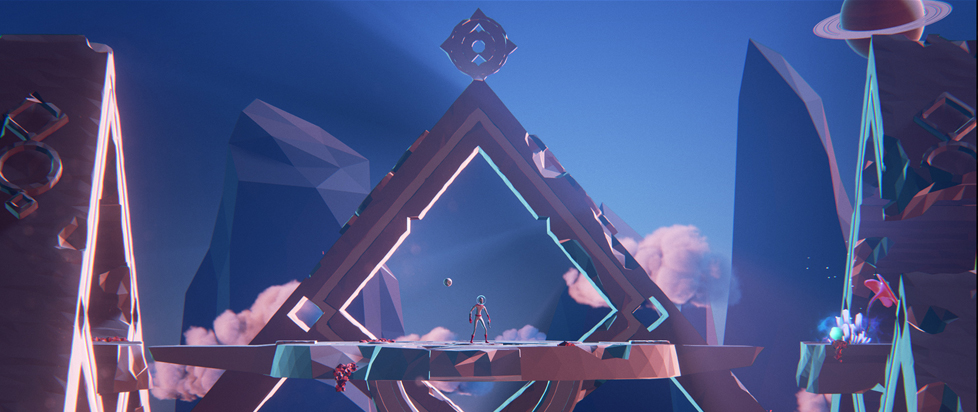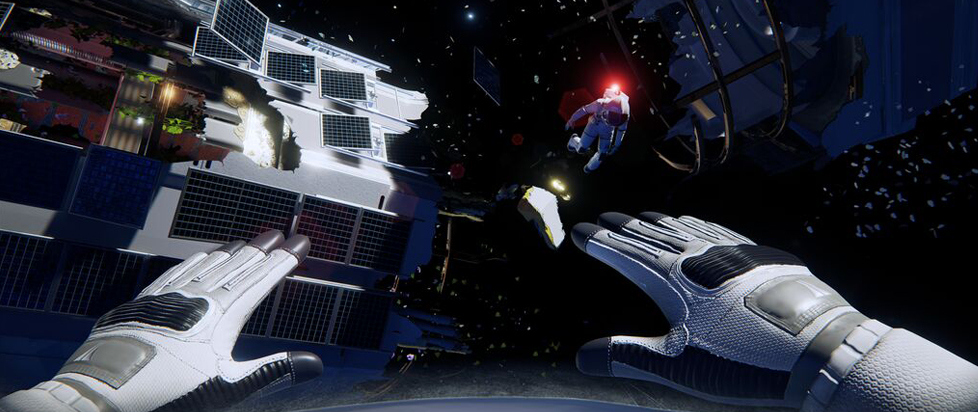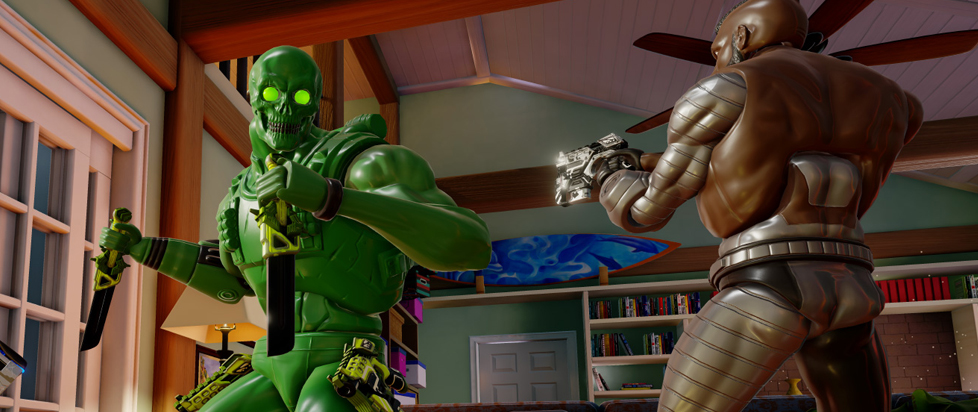
Revving the Engine: Planet Alpha 31
The following is a reprint from Unwinnable Weekly Issue Sixty Nine. If you enjoy what you read, please consider purchasing the issue or subscribing.
This series of articles is made possible through the generous sponsorship of Epic’s Unreal Engine. While Epic puts us in touch with our subjects, they have no input or approval in the final story.
———
A lone engineer, in a strange, alien place that blurs night and day, on a mission to survive by solving seemingly endless puzzles and mysteries.
That could be a description of the protagonist of Planet Alpha 31. It may also apply to the game’s lone developer, Adrian Lazar.
Lazar started working in the post–production industry when he was 17 years old, doing freelance as 3D artist. In 2009, after switching studios a few times, he took a job at IO Interactive, developers of the Hitman series. “That was my first interaction with game development and, as an artist, I found the medium liberating,” he says. In 2013, he took a job as Senior Technical Artist at Full Control, a small indie studio responsible among others for Space Hulk: Ascension. Though the studio would shutter two years later, working on diverse tasks in a small team proved addictive. He realized he no longer wanted to be a small wheel in someone else’s machine.
“I wanted more control, more artistic freedom and I wanted to develop my own game,” he says. “In the past 13 years or so I gathered enough skills and experience and I decided this is the moment to make the jump and become independent.” To make that a reality, Lazar turned to an old side project.
Lazar had started working on Planet Alpha 31 over Christmas break in 2013, but his efforts only lasted a few months before frustrations with the development pace and a crunch period at his day job derailed the project. If it wasn’t for the release of Unreal Engine 4 a few months later, the game would have never seen the light of day.
”I saw the potential for the blueprint visual scripting, rapid prototyping and amazing rendering features,” says Lazar. He kept up with the project in the months since and that potential has paid off. Just last month, the Danish investment group CAPNOVA A/S, the same folks whose money made Playdead’s Limbo possible, fully funded Planet Alpha 31 – a dream come true for Lazar.
Lazar took time out to chat about his game, his influences and the challenges of going it alone.
What’s the inspiration behind the Planet Alpha 31?
I was always a huge sci–fi fan and I’ve become fascinated with space exploration and alien worlds ever since my father was forcing me to watch Star Trek when I was a kid.
A few years ago I stopped playing videogames. It happened gradually – a combination of having little free time and no longer enjoying the games that were coming out. Maybe it was the age, maybe it was because games were becoming dumber and dumber but I just lost interest.
Then, a couple of years back, I played the iPad version of Another World – a game that I missed when I was younger. I loved it! I loved the gameplay and I loved the graphics, but what I loved the most was that feeling of being on a strange, alien planet – something I’m trying to offer in Planet Alpha 31 as well. Another World re–ignited both my love for videogames and my love for sci–fi and space exploration. Some people have said that they can see the influence of Another World in Planet Alpha 31 and it’s not a coincidence.
The game looks great and has a very distinct visual style. Can you speak a bit about how that developed and what influenced it?
The art style was researched and developed over many months to ensure it can offer an immersive experience for the players, and it’s something I’m still adjusting today. At the same time, it had to be easy to produce, as I knew from beginning that the game would be developed either by me alone or by a very small team. I embraced strong, saturated colors, contrast in sizes, shapes and lighting and I think this played a big role in making the game look distinctive.
There are many sources that inspired the visuals of Planet Alpha 31 – from ancient Greek architecture to the vintage look of Star Trek, Alien and Aliens to the amazing futuristic design found in cities like Singapore to space photography –we live in an amazing world with no shortage of inspiring sights.
You’ve said the game is tribute to games of old that didn’t hold your hand. Any titles in particular? Can you talk about difficulty as a both a design choice and a design challenge?
I grew up with games like Quake and Unreal. They had great level design, filled with secret areas, hidden enemies, keys that I had to find, etc. And while at times I felt lost, I always felt challenged – and for me this is something important to have in Planet Alpha 31. You’re alone on an alien planet, you’re an engineer, not an action hero – you are both intrigued and scarred, both amazed and cautious. To survive you will have to explore and to be observant of this strange place – head on approach rarely works – think before you shoot.
The planet itself has some unique mechanics. Can you describe how they work and how they came about?
I’m trying to create a living world where the visuals influence the game mechanics and vice versa. For example, the realtime day and night cycle affects the gameplay but, at the same time, the player can affect the day and night cycle. For me, this constant connection between gameplay, visuals and audio, is key to create an immersive experience.
Most mechanics were just thought about, but some were prototyped on paper or tested directly in game – something that Unreal Engine is very good at. The tricky part was picking the ones that were fun and offered most gameplay opportunities, and implementing them. Rejecting my own ideas wasn’t easy, but I rather have a few solid mechanics that work well than risk spreading the game too thin.
Having limited resources means that I have to constantly keep an eye on the big picture while at the same time focus on the small details – a skill I learned over time in the hard way.
Have there been exceptions to that self-editing?
There were a few moments when I got an idea for a visual feature or for a game mechanic that I just knew I had to implement, no matter how difficult or time consuming it would be otherwise I wouldn’t make my own game.
The most important one – the day/night cycle – was developed while I was in vacation, waiting for feedback from an investor interested in supporting Planet Alpha 31. He got back to me saying that he likes the game but feels like it’s missing some feature to make it more unique. It was a bit of a shock, because I thought at that point the game was strong enough but it was also a huge motivation to come up with something special.
After a few days of brainstorming and panic it clicked: I have this real–time day and night cycle, so what if the player could affect it somehow. Visually it would look impressive, but more importantly it’s a mechanic that can be tied in all three main gameplay pillars: puzzles, platforming and action.
The Daytime Manipulation Mechanic (I need to come up with a better name) gives the player the ability to change the planet’s rotation, going fast forward or fast backwards, and this allows him to interact with special alien structures and to affect the planet’s biosphere. This is the kind of feature that requires changes throughout the entire game, from visuals to gameplay to audio, but I had to implement it, otherwise I knew I wouldn’t make the best game I could.
The investor talks didn’t work out due to other reasons, but I’m very happy about getting that kick to push the game to another level.
You were the sole developer working on Planet Alpha 31 for most of its existence – was working solo a goal for you?
Working alone wasn’t the goal for me. Instead, what I wanted was to be able to work on my own game and to have total creative freedom, something that you just cannot have in large studios or even in medium size teams. It’s also nice not to have to pay for other people mistakes. And sure, I will make mistakes, already made a few, but are my mistakes to make.
It wasn’t my intention to work on Planet Alpha 31 alone, I just didn’t have any other choice until now, when the project got founded. Even with the project financed, this will be a two- or three-man team. I’m a bit of a control freak, so I will always be involved in every aspect of the game but I like to believe that I’ll know how to give my future colleagues enough creative freedom so that they can feel motivated while keeping my vision for the game intact.
I worked on Planet Alpha 31 alone for nearly two years and I know that from January it won’t be only my game anymore. It will always be my baby, but I’ll have to share it with others. I’m fine with that. I believe I found the right people to join me and I couldn’t be more excited about the future.
What gave you the most trouble going it alone?
The biggest challenge for me is that you have to think about everything. And I mean every single thing about the game, not only the obvious ones like game-play, art-style and story, but also menus, UI, localization, control scheme, audio and I could go on forever. It’s easy to get tangled in details and lose focus on the big picture. That happened a few times and I had to go back and redo the level design because the game was moving away from what I wanted to be. At the same time, I enjoy learning all these things, even if I found some boring. I must admit, there is a bit of pride knowing that it’s all me.
I can’t help but wonder, is there some correlation between the lone survivor of Planet Alpha 31 and Adrian Lazar, lone developer?
I believe you are totally right. At a certain level, the game is influenced by my life and being such a personal project. I don’t think it could have been any other way. I never thought about it, but it makes sense. I guess I was always independent, moving out from home when I was 18, at 26 I left my home country and moved to Denmark. It’s just a great feeling to be able to provide for yourself, without relying on anyone.
Why’d you chose UE4 to develop the game?
I started working on the first version of Planet Alpha 31 using Unity3D and progress went fine at the beginning. However, after a while I started to need more control from the engine – the prefab system was becoming limiting, there were few options to debug render issues and post–processing lacked in overall quality.
Unity is a good engine but my project outgrew it – as the game became more and more complex so did the requirements for the tools grew. After half a year I stopped the development, becoming frustrated with the slow pace the project was advancing at that point.
I took a break for a couple of months then I started experimenting with UE4 – it was still new but I was instantly impressed. The blueprint system is extremely powerful, it offers more debug options then I will ever use and the renderer is state of the art. More importantly, the node based workflow fitted me better since both Houdini and ICE (XSI), tools that I worked with for years, share the same design.
Having solid tools that you can trust is always important, but it is even more so when you are indie. Limited time and resources means that I need to rely heavily on the software developers and good communication is key. Luckily Epic Games does a great job at being transparent with weekly streams, lots of devs joining the discussions on the forum and a public roadmap so you know what’s coming next.
How is it developing a classic side-scroller in UE4? Does it pose or solve any particular challenges?
While UE pedigree is built on first person shooters, I find Unreal Engine 4 very suited for a side-scroller and the game templates that they offer are a huge help. Planet Alpha 31 started in their side-scroller template and still uses a bit of logic and some animation from there. Having a fully 3D environment creates a great sense of depth and scale in the game, something harder to achieve in 2D.
How did the Unreal Dev Grant come about? How has it changed things?
Planet Alpha 31 was among the first six recipients of the Unreal Development Grant, and when I applied they already had a few hundred submissions so I wasn’t very optimistic.
It’s hard to say just how important receiving the Unreal Development Grant was for Planet Alpha 31. At that time things were going pretty bad at my full-time job, I was very tired and started to feel demotivated – the grant helped immensely, it was the first confirmation that the game was going in the right direction. And while the amount is not much for development (half going in taxes), it did allowed me to attend Casual Connect/Indie Showcase Singapore were the game won three awards. These awards, plus the fact that I received the development grant, made finding an investor to finance the game a lot easier.
Without the grant the game might have never got this far and I might not live my dream of being an independent developer.
How was your reception at Casual Connect?
It was the first time I showed Planet Alpha 31 publicly and I was terrified – the night before I was still fixing bugs in the hotel room and I had a million questions. Was the gameplay fun? Was it too difficult or too frustrating? Was the level design was any good? Luckily the reception was great and a lot of valuable feedback was gathered.
To top it off, the game won three prizes during the award ceremony: Best in Show, Most Promising Game in Development and Best Visual Style, all of which confirmed that the game was developing in the right direction.
———
Stu Horvath is the editor in chief of Unwinnable. He reads a lot, drinks whiskey and spends his free time calling up demons. Sometimes, he plays with toys and calls it “photography.” Follow him on Twitter @StuHorvath.




